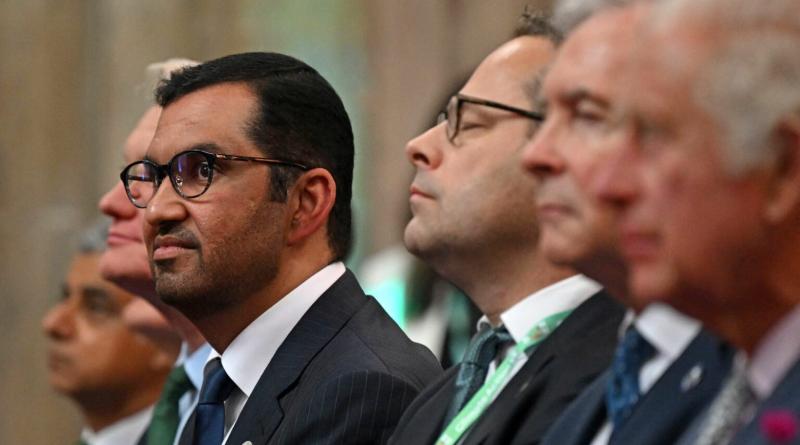Six Numbers Illustrating Why COP28 Could Be a Heavy Lift for World Leaders

This year’s U.N. climate summit could be an especially important one as carbon emissions continue to reach historic highs, bringing the planet closer to critical tipping points.
More than 70,000 diplomats, politicians, business leaders and environmental advocates from all around the world are expected in Dubai on Thursday for COP28, the United Nations’ flagship climate change summit.
Each year, delegates from nearly 200 nations gather at the conference to discuss how they can limit rising global temperatures through the end of the century in hopes of avoiding the most dire consequences of climate change, including upwards of three-quarters of Earth’s species disappearing for good.
But this year’s conference could be an especially important one as carbon emissions continue to reach historic highs and the planet approaches potential tipping points that scientists fear could send global warming spiraling out of control. With climate and energy experts stressing the need to immediately reduce the use of fossil fuels if nations hope to keep the Paris Agreement targets alive, and with wars raging in Europe and the Middle East, world leaders face significant challenges at the talks.
These six indicators help illustrate the extent of those challenges and what’s at stake if nations fail to reach some key agreements, including a deal to phase down fossil fuels.
1 percent
That’s how much of the global investment in renewable energy last year came from fossil fuel companies, according to a new report by the International Energy Agency, a nonpartisan energy watchdog group and one of the world’s most respected energy analyst firms.
Clean energy saw record growth last year, with new capacity increasing nearly 10 percent globally from the previous year, data shows. But 2022 was also a blockbuster year for fossil fuel companies, which took in $200 billion in profits—more than double what the industry made the prior year.
Taken altogether, the numbers show that fossil fuel companies, whose products are largely responsible for causing the climate crisis, are not taking the clean energy transition seriously and are in fact planning to dramatically expand their oil and gas production decades into the future.
That’s a major problem if nations actually want to achieve the Paris Agreement targets of limiting the planet’s average warming to at least 2 degrees Celsius above pre-industrial levels, with the hopes of keeping it below 1.5 degrees, the IEA’s new report said. The agency has previously said that global installations of renewable energy must triple by 2030 to keep those targets alive.
“The oil and gas industry is facing a moment of truth at COP28 in Dubai. With the world suffering the impacts of a worsening climate crisis, continuing with business as usual is neither socially nor environmentally responsible,” said IEA Executive Director Fatih Birol in a statement. “Oil and gas producers around the world need to make profound decisions about their future place in the global energy sector.”
3 percent
That’s how much U.S. carbon emissions are expected to fall by the end of this year, E&E News reports, marking some positive news for climate advocates after the nation failed to reduce its emissions in 2022 and 2021. In fact, it would be one of the largest annual emission declines of the last decade.
The projection comes from two recent analyses, one from the International Energy Agency and the other from Carbon Monitor, a multi-university effort to track emissions. But the outlook also comes with notable caveats.
For one, the U.S. was already trending downwards before the Covid-19 pandemic upended the global economy, and a 3-percent drop essentially resumes that previous trajectory rather than pointing to an accelerated effort to tackle climate change. And secondly, while that reduction is historic in its own right, the U.S. would need to reduce its carbon emissions by 6 percent every year through 2030 just to keep on track with its climate goals under the Paris Agreement.
Considering the U.S. is historically the largest contributor to climate change and wields outsized influence in global negotiations, this could be an ominous signal for the climate talks this week. Surely, other nations will be watching how the Biden administration addresses this gap and whether it offers any solutions to help close it.
16 percent
That’s how much of the total carbon emissions released in 2019 globally came from just 77 million of the world’s richest people, according to a new report from the Guardian, Oxfam and the Stockholm Environment Institute. That means the activities of a tiny fraction of the global population contributed a whopping 5.9 billion metric tons of carbon dioxide to the atmosphere that year—more CO2 than released by the planet’s poorest 66 percent, the report added.
It has long been known that wealthy nations are largely responsible for causing climate change, releasing far more greenhouse gas emissions than developing countries, which disproportionately bear the brunt of climate-related harms. The new report is the latest to highlight just how astonishingly wide of a gap exists between wealthy and poor individuals with regards to their carbon footprints.
This will be a key issue delegates plan to address at COP28, as they attempt to map out the details for the United Nations’ loss and damages fund. The landmark fund was established during last year’s summit, but nations have yet to decide how exactly it will operate, including who must pay into the fund and by how much. It’s a touchy subject, and wealthier countries like the United States have frequently opposed such a fund, arguing that the effort should remain voluntary.
135 million
That’s how many metric tons of methane were released into the atmosphere in 2022, according to the U.N. It’s a significant amount with serious implications considering that methane is roughly 80 times more potent at warming the planet than carbon dioxide over a 20-year period.
That’s why nailing down a deal on slashing methane emissions will be a priority at this year’s COP, Reuters reports. While more than 150 countries have promised since 2021 to reduce their methane emissions 30 percent below 2020 levels by 2030 under the Global Methane Pledge, few have detailed how they will achieve this.
Climate scientists have said curbing global warming is impossible without addressing the world’s methane emissions, and advocates are watching closely on whether nations commit to robust plans to address this critical issue.
$150 billion
That’s the annual cost to the U.S. economy due to related disasters, including hurricanes, droughts and wildfires, according to the latest National Climate Assessment released earlier this month.
The White House report said it considers that estimate to be conservative. It also said that cost would only balloon further as climate change accelerates, making extreme weather events more frequent and severe across the nation. The U.S. now experiences a billion-dollar disaster every three weeks, on average, the report said, opposed to every four months during the 1980s.
That cost includes things like water stress, agricultural loss, tourism impacts, falling real estate value and damage to property and infrastructure. As delegates at COP28 debate how to best adapt to the new climate reality, the steep cost faced by the United States alone offers a glimpse at the growing scope of the problem.
1.8°C
That’s how much hotter the month of September was compared to pre-industrial levels, scientists announced last month, a stunning revelation that one researcher described as “absolutely gobsmackingly bananas.”
Scientists now say there’s no doubt that 2023 will be the hottest year on record. Still, September was an especially notable month, shattering the previous record by half a degree Celsius, the largest year-to-year jump in monthly temperatures ever observed by humans.
The outcome of COP27 last year was widely viewed by climate advocates as underwhelming. With 2023 turning out to be a record-breaking year on several climate fronts, September’s outlandish temperatures may offer the best representation to date of what’s at stake if COP28 follows suit.





